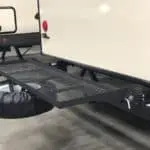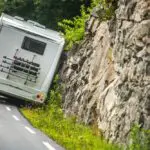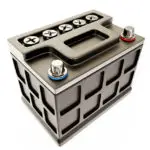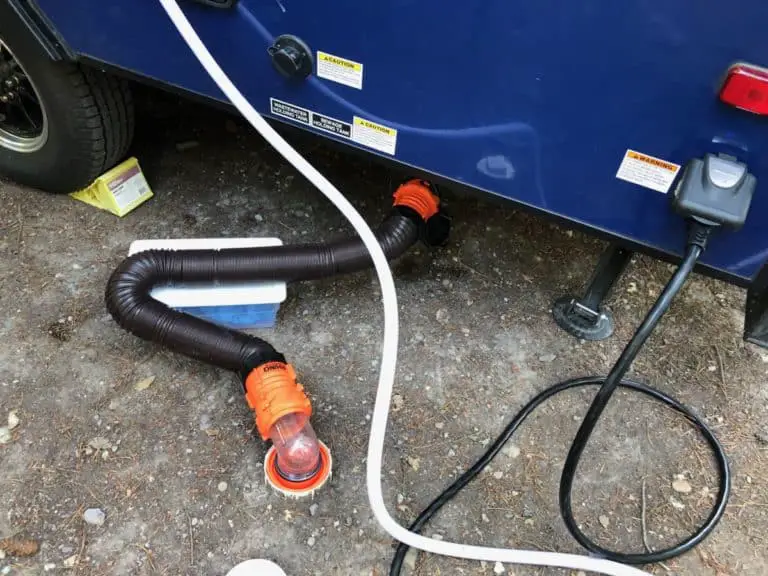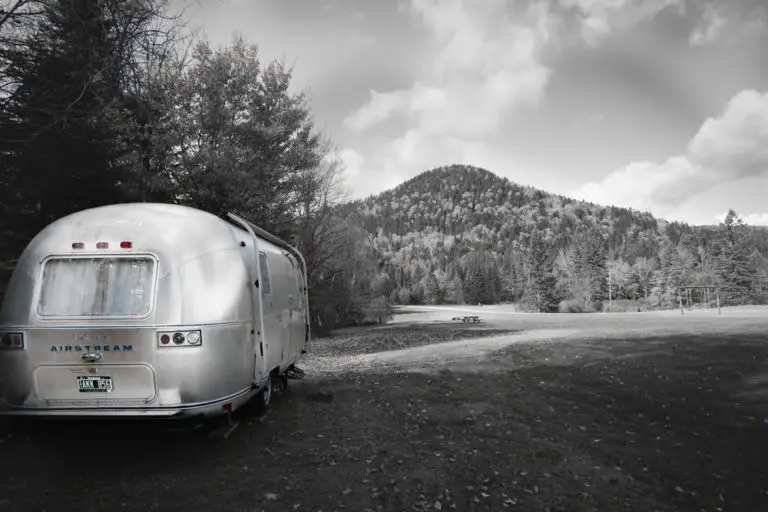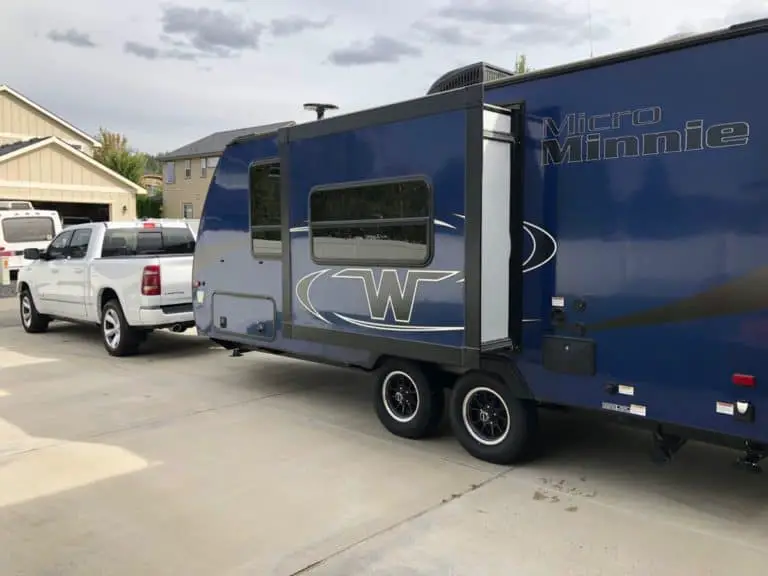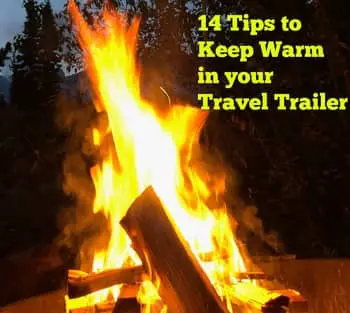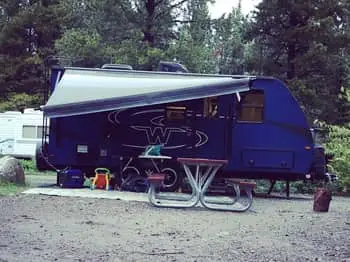How to Backup a Travel Trailer in a Tight Spot
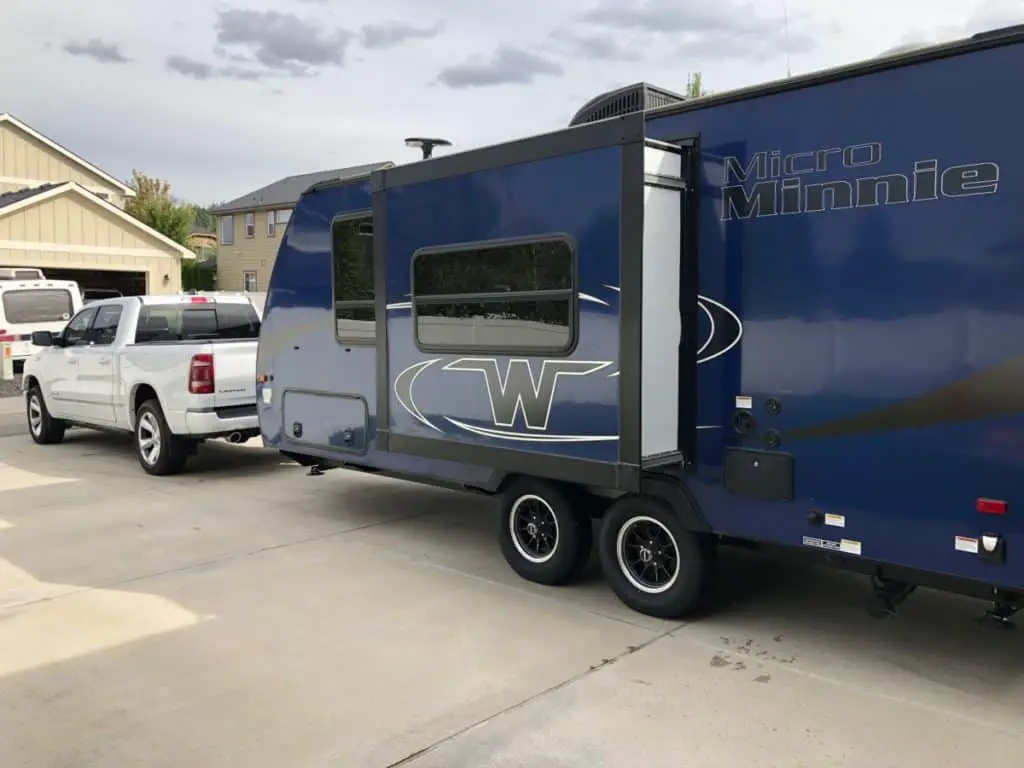
So, you’ve finally invested in that portable camper that you’ve always wanted, have you? You must be over the moon! After all, you’ve only been talking about it for months at this point, and have probably thought about getting one for years. You’re only a day away from enjoying that camping trip, at last!
After so long you and your family will get to spend the weekend on a much needed get away. Surrounded by the peacefulness of nature. You all must be so excited! However, there is only one more thing that you must do….. Figure out how to back your nearly acquired toy into the campsite or driveway!
How to backup a travel trailer? To backup a travel trailer, first drive past the site, next get out of your tow vehicle and assess where you want your trailer to rest within the site. Perform an “S” turn to back into your campsite. Pull forward to streighten out and back up to place the trailer in the final resting spot.
It should be easy… Right?
Not exactly…
However, with the following tips and tricks, you’ll find it to be much easier than anticipated. However, before you prepare yourself to practice parking your travel trailer, you’ll need the following things.
- A little bit of courage
- Some one you trust to spot you
- A set of short range walkie talkies
- A LOT of patience
Once you have gathered each of the above item(s) and/or individual(s)you’re ready to begin the process of learning how to park your backup travel trailer.
By the end of this article you will have the necessary step-by-step knowledge regarding how to safely, efficiently, and readily park your new camper in any campsite.
As you continue reading you will learn how to approach the campsite, adjust your mirrors and use RV back up cameras (if applicable), how to determine what is considered adequate space to set up camp once your trailer has been parked, the proper execution of the “S” turn, tips for effective communication with your chosen spotter while backing up, and suggested places for practice prior to your first trip.
Step by Step Backing Up Instructions
Step 1: The Approach
When approaching your chosen campsite, remember to pull slightly past(although the exact distance varies depending on your specific trailer length). You will want to ensure that you are on the same side of the road as your parking space, rather than the opposite.
While it is tempting to approach from the opposite side, this will only create difficulties and increase frustration later down the road. After all, you need to have enough room to safely maneuver both your towing vehicle and trailer into the parking space.
Step 2: Analyzing the Campsite
Now that you have chosen the exact campsite or parking space that you wish to pull into, take a moment and get out of the vehicle. Make sure that there is no oncoming traffic prior to getting out of the truck/SUV. Take a few minutes to analyze the parking space. How much room is there? Where do you want to park within the allotted space? Is there enough room for your particular trailer? Get back in the vehicle.
Step 3: Determining Where to Park and Working with a Spotter
After analyzing your campsite, determine where in the parking space you would like for the trailer to sit. Make sure that there is enough remaining space on either side of the trailer for activities that you and your family would like to do.
Once that is complete, discuss briefly with your spotter about where you would like to park so that you are both on the same page. Make sure that you each have a walkie talk and/or hand signals have been clarified. Prior to pulling back, ensure that you can clearly see your spotter in your mirrors. If not, stop the vehicle and take a moment to relocate your spotter.
If you would like, you can place a rock or wheel chock to mark the area where you want the wheels to go to give you a gauge to aim for. This is extremely helpful.
Step 4: Conducting the “S” Turn
Now, place your hand at the bottom of the steering wheel in approximately the 6 o’clock position. Turn the wheel to the left or right, depending on where the site is, so that you are turning into the middle of the lane. Make sure to check for any oncoming traffic prior to pulling out.
Once you have pulled out into the middle of the road, double check that you can still see your spotter in the review mirror and cut the wheel in the opposite direction of your original turn. SLOWLY, start backing up. Continue to communicate with your spotter as you do so. Do not hesitate to pull forward and straighten out or get out of the vehicle and analyze the situation if needed.
Step 5: Straightening Out and Settling In
Once you have pulled into the parking space, double check that you are straightened out. If not pull forward and determine whether you need to move to the right or left. Make sure to straighten out the trailer and back up into the space. Do this as many times as is required until you and your spotter are satisfied.
After you have straightened out to your satisfaction, you may unhitch your trailer from the vehicle if you so desire. Make sure that the trailer is level, and begin setting up camp. Once all last minute details are complete, kick back and relax.
6 Things to Consider When Learning to Back Up Your Travel Trailer
Orient Yourself
Once you have purchased your very own RV/ travel trailer it is wise to take the time to orient yourself with its features. You should take into consideration the relative length of the trailer (is it longer or shorter?), and how that size will affect the reaction speeds while you’re backing up.
Generally, the longer the travel trailer the slower the reaction time; and the shorter the trailer the faster the reaction speed. Consequently, it is thought by many to be easier to correctly park a larger RV than a smaller one.
In addition to the relative length of the trailer, it is crucial to consider where lies the pivot point of the trailer. The pivot point is the exact point on the trailer upon which it rotates during a turn. Exactly where this point is located is somewhat dependent upon the size and type of backup travel trailer you have purchased. This may be at the axle point if your axles are towards the middle of the trailer.
Taking the time to determine where this point is hidden will help you and your spotter more effectively back into any space of your choosing. Once you are aware of where lies the pivot point on your trailer, you can more effectively determine when you must start cutting the wheel of your towing vehicle to back into the desired space.
Familiarizing yourself with your trailer further allows you to determine exactly at what angle the vehicle may be at prior to the trailer jackknifing against the hitch. You must be careful not to jackknife the trailer and truck or SUV to ensure that neither vehicle sustains damage.
Adjust Mirrors or Backup Cameras
Similar to when you are operating any other vehicle, it is crucial that you appropriately adjust the mirrors on your towing vehicle. You will know that the mirrors have been properly adjusted when you can see the entire next lane behind your trailer.
This is essential to have done correctly so that you may continue to safely travel from point “A” to point “B”. Remember that due to the height of the travel trailer your review mirror has become useless. As such you must use your sideview mirrors to safely navigate the traffic and any other obstacles behind you.
As with the review mirror in your towing vehicle, if there is an installed back up camera, it won’t help you much either. However, there are separate RV backup cameras available for purchase. As with the cameras in your vehicle, always be sure to check your surroundings thoroughly prior to backing up.
Get Out of Vehicle and Analyze the Spot
While backing your travel trailer into the camping site or driveway of your choice it can be helpful for you to get out and assess where the trailer will be parked and that it is within the bounds of the desired space. Is it too close to the right? Maybe it’s too far into the parking space leaving no room for any other activities to take place.
When analyzing the utilization of the campsite it is important to ensure that there is enough space for the camper/ travel trailer to fit comfortably when fully extended (if there are awnings, slideouts or any other extended features).
Learn the “S” Turn
Mastery of the “S” turn will not only help you to accurately park your trailer, but it is also a necessity for backing it up safely. Due to the extended length of most RVs and trailers, you are not able to simply just back up and call it good. Instead, you will have to angle and slowly, carefully maneuver vehicle and trailer into position.
The “S” turn will have you turn the vehicle left or right, depending on which side of the road you’re on, so that you have positioned the towing vehicle in the middle of the road and the trailer at the correct angle of the parking space.
You then back up, stop, access your location relative to where you wish to come to a halt, and then cut the wheel in the opposite direction of your original turn. This allows for the vehicle and trailer to have straightened out. Consequently, you will be able to simply put your truck/SUV in reverse and pull straight back.
If you have gone too far, you can pull forward and recorrect your angle.
Have a Spotter
While having a spotter is not necessarily required, it can make backing the travel trailer into the campground or driveway significantly easier. Your spotter will serve as a second pair of eyes; seeing what you will be unable to.
Having a set of short distance walkie talkies will make this even easier. However, in the event that you either do not have walkie talkies on hand or they fail designated hand signals (right, left, straight back, slow down, stop, etc.) should be determined prior to parking.
It is important that you do not yell at your spotter. The risk of losing your temper and experiencing a great deal of frustration can be avoided by communicating where you would like for the trailer to be parked with your chosen spotter ahead of time.
This can be accomplished by simply taking five minutes or less to examine your anticipated campground. Once this has been determined your spotter can head on back behind the trailer and you can begin the process of parking.
Remember, be patient!
Practice
As the saying goes, practice makes perfect; and that is just what you will need prior to your first trip. Ideally, you should find a large, relatively empty parking lot to practice in. This will give you plenty of space and time to maneuver your trailer into a parking space. Not only will you be able to get a handle on all of the above tips, but you will also get a more hands on understanding of your travel trailer.
While it will take time to perfect the art of parking a trailer, taking it out several times before your first camping trip will save you quite a bit of time once you have reached your destination. Plus, it will hopefully result in a decrease in frustration the first couple of tries.
In addition to helping you get a hold on how to park your trailer, learning these techniques ahead of time will provide you with even further hands on knowledge. Of course, mastering how to handle your individual trailer will come with time and of naturally with practice.
Congratulations! You now know how to successfully and safely back up your new travel trailer into any parking space. Go forth, have fun, maybe share your new found knowledge, and most importantly, enjoy your new trailer fearlessly.
Be the first to be notified about FREE tips, hints, coupon codes, and email-exclusive information. All for FREE!


